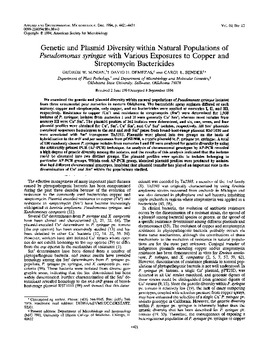| dc.contributor.author | Sundin, George W. | |
| dc.contributor.author | Demezas, David H. | |
| dc.contributor.author | Bender, Carol L. | |
| dc.date.accessioned | 2015-10-16T20:47:40Z | |
| dc.date.available | 2015-10-16T20:47:40Z | |
| dc.date.issued | 1994-12 | |
| dc.identifier | okds_Bender_AEM_1994-12.pdf | |
| dc.identifier.citation | Sundin, G. W., Demezas, D. H., & Bender, C. L. (1994). Genetic and plasmid diversity within natural populations of Pseudomonas syringae with various exposures to copper and streptomycin bactericides. Applied and Environmental Microbiology, 60(12), 4421-4431. https://doi.org/10.1128/aem.60.12.4421-4431.1994 | |
| dc.identifier.uri | https://hdl.handle.net/11244/19762 | |
| dc.description.abstract | We examined the genetic and plasmid diversity within natural populations of Pseudomonas syringae isolated from three ornamental pear nurseries in eastern Oklahoma. The bactericide spray regimen differed at each nursery; copper and streptomycin, only copper, and no bactericides were applied at nurseries I, II, and III, respectively. Resistance to copper (Cur) and resistance to streptomycin (Smr) were determined for 1,938 isolates of P. syringae; isolates from nurseries I and II were generally Cur Sms; whereas most isolates from nursery III were Cus Sms. The plasmid profiles of 362 isolates were determined, and six, one, seven, and four plasmid profiles were obtained for Cur, Smr, Cur Smr, and Cus Sm' isolates, respectively. All Smr plasmids contained sequences homologous to the strA and strB Smr genes from broad-host-range plasmid RSF1010 and were associated with Smr transposon Tn5393. Plasmids were placed into two groups on the basis of hybridization to the oriVandpar sequences from pOSU900, a cryptic plasmid in P. syringae pv. syringae. A total of 100 randomly chosen P. syringae isolates from nurseries I and III were analyzed for genetic diversity by using the arbitrarily primed PCR (AP-PCR) technique. An analysis of chromosomal genotypes by AP-PCR revealed a high degree of genetic diversity among the isolates, and the results of this analysis indicated that the isolates could be clustered into two distinct groups. The plasmid profiles were specific to isolates belonging to particular AP-PCR groups. Within each AP-PCR group, identical plasmid profiles were produced by isolates that had different chromosomal genotypes, implying that plasmid transfer has played an important role in the dissemination of Cur and Smr within the populations studied. | |
| dc.format | application/pdf | |
| dc.language | en_US | |
| dc.publisher | American Society for Microbiology | |
| dc.rights | This material has been previously published. In the Oklahoma State University Library's institutional repository this version is made available through the open access principles and the terms of agreement/consent between the author(s) and the publisher. The permission policy on the use, reproduction or distribution of the material falls under fair use for educational, scholarship, and research purposes. Contact Digital Resources and Discovery Services at lib-dls@okstate.edu or 405-744-9161 for further information. | |
| dc.title | Genetic and plasmid diversity within natural populations of Pseudomonas syringae with various exposures to copper and streptomycin bactericides | |
| osu.filename | okds_Bender_AEM_1994-12.pdf | |
| dc.description.peerreview | Peer reviewed | |
| dc.identifier.doi | 10.1128/aem.60.12.4421-4431.1994 | |
| dc.description.department | Plant Pathology | |
| dc.description.department | Microbiology and Molecular Genetics | |
| dc.type.genre | Article | |
| dc.type.material | Text | |
